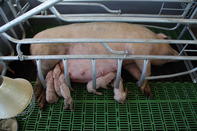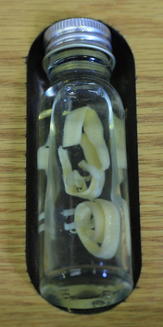
Roundworms
Roundworm (Ascaris suum) is the most pathogenic worm of pigs. The worms, which can grow as thick as a pencil and up to 400 mm in length, live in the gut of the pigs where they take feed from the pig. The worms produce huge numbers of eggs that are excreted via the faeces of infected pigs. The eggs are extremely hardy and can survive for years.
Young piglets are the most susceptible to infection, generally getting infected when they swallow eggs from dirty udders. Where there is a risk of infestations, sows should be dewormed at least two weeks before farrowing and washed a couple of days before then.
Clinical signs of infestation depends on the severity, ranging from a dry unproductive cough in mild cases to diarrhoea and poor growth in serious cases. The worms may also cause pneumonia and blockages of intestines. A diagnosis can be confirmed by the examining the faeces of pigs for the presence of eggs or during a post mortem.
The worms cause white spots in the liver of the pigs. Good management and hygienic practices can help to prevent infections and to keep infestation rates low. If pigs are kept outside, rotational grazing should be used to prevent a build-up of eggs in pastures. Several anthelmintics (antiparasitic drugs that expel parasitic worms) are registered to manage infestations.
For the best results, these should be used according to instructions. Herbs such moringa are also known to have anthelmintic properties.
Tapeworm

Pigs act as an intermediate host for tapeworm during its bladder worm stage (Cysticercus cellulosae) and are infected when they ingest excreta from humans, who serve as the primary hosts. The worms during their phase in humans are known as Taenia solium. Humans are infected when they eat undercooked infected pork.
The condition is commonly referred as measles in pigs, since the worms manifest as small white nodules of up to 15 mm in the stomach, intestine, heart, diaphragm and skeletal muscles. They usually do not cause discomfort, but in some cases may cause pain making it difficult for the pigs to move.
Infestations are generally only discovered after the pig is slaughtered, resulting in the condemnation of the carcass. Improved sanitation and hygienic practices has resulted in measles becoming very rare in pigs.
There is no cure for it, so the disease should be prevented by keeping pigs from wandering in places where they can feed on human faeces and by making sure people who live and work in areas where pigs are produced, use toilets and wash their hands before working with pigs after they have used the toilet.